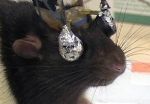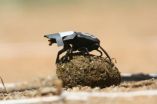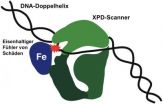(Press-News.org) In experiments on rats outfitted with tiny goggles, scientists say they have learned that the brain's initial vision processing center not only relays visual stimuli, but also can "learn" time intervals and create specifically timed expectations of future rewards. The research, by a team at the Johns Hopkins University School of Medicine and the Massachusetts Institute of Technology, sheds new light on learning and memory-making, the investigators say, and could help explain why people with Alzheimer's disease have trouble remembering recent events.
Results of the study, in the journal Neuron , suggest that connections within nerve cell networks in the vision-processing center can be strengthened by the neurochemical acetylcholine (ACh), which the brain is thought to secrete after a reward is received. Only nerve cell networks recently stimulated by a flash of light delivered through the goggles are affected by ACh, which in turn allows those nerve networks to associate the visual cue with the reward. Because brain structures are highly conserved in mammals, the findings likely have parallels in humans, they say.
"We've discovered that nerve cells in this part of the brain, the primary visual cortex, seem to be able to develop molecular memories, helping us understand how animals learn to predict rewarding outcomes," says Marshall Hussain Shuler, Ph.D., assistant professor of neuroscience at the Institute for Basic Biomedical Sciences at the Johns Hopkins University School of Medicine.
To maximize survival, an animal's brain has to remember what cues precede a positive or negative event, allowing the animal to alter its behavior to increase rewards and decrease mishaps. In the Hopkins-MIT study, the researchers sought clarity about how the brain links visual information to more complex information about time and reward.
The presiding theory, Hussain Shuler says, assumed that this connection was made in areas devoted to "high-level" processing, like the frontal cortex, which is known to be important for learning and memory. The primary visual cortex seemed to simply receive information from the eyes and "re-piece" the visual world together before presenting it to decision-making parts of the brain.
To monitor the vision-reward connection process, the team fitted rats with special goggles that let researchers flash a light before either their left or right eye. Thirsty rats with goggles were given access to a water spout inside a testing chamber. When they approached the water spout, a brief visual cue was presented to one eye.
If light was sent to the left eye, the water spout would have to be licked a few times before water came to the rat; if light was sent to the right eye, the rat would have to lick many more times before water came. After a few daily sessions of such "conditioning" (not unlike Pavlov's famous dog-bell-reward experiments), the rats learned how long they would have to lick before getting a water reward. If they didn't get the reward in the expected amount of time, they would give up and leave the spout.
Monitoring the pattern of electrical signals given off by individual nerve cells in the rat brains, the researchers found that the signals' "spikes" weren't just reflecting the visual cue alone. Rather, the signals seemed to relay the time of expected reward delivery through altered spiking patterns. They also saw that many nerve cells seemed to report one or the other visual cue-reward interval, but not both. In cells stimulated by a flash to the left eye, the electrical signal returned to its baseline after a short delay, in sync with the timing of the water reward; a cue to the right eye correlated with a longer delay, also in sync with the reward. According to the researchers, the amount of time that passed before nerve cells returned to their resting state was the brain's way of setting up a "timed expectation."
Knowing that the basal forebrain is implicated in learning, the researchers wanted to know if their observations could be explained by nerves from the basal forebrain delivering ACh to the vision-processing center. To remove those nerve cells from the equation, they paired a neurotoxin with a "homing device" that targets only ACh-releasing neurons coming from the basal forebrain. They then repeated their experiments in trained rats that received the neurotoxin and in those that didn't, and found that the nerve cell signals continued to relay the old time intervals, suggesting that ACh and the basal forebrain weren't needed to express previously learned time information.
The researchers next used those same rats to ask if ACh is necessary for nerve cells to learn new time delays. To do that, they switched the visual cues so that a flash in the left eye meant a long delay and one in the right eye meant a short one. Vision-processing nerve cells in the rats in which ACh delivery was left intact adapted their signals to the new associations; but those in the rats that no longer received ACh continued to relay the old associations, suggesting that ACh is necessary to make new associations but not to express old ones.
Hussain Shuler explains, "When a reward is received, ACh is sent throughout the brain and reinforces only those nerve cell connections that were recently active. The process of conditioning continues to strengthen these nerve connections, giving rise to a timed expectation of reward in the brain."
According to Hussain Shuler, studies have shown that Alzheimer's patients have low levels of ACh and have trouble forming new memories. Though medication may elevate ACh, alleviation of symptoms is limited. "Our research explains that limitation," he says. "Therapeutically, we predict that the problem isn't just low levels of ACh — the timing of ACh delivery is key."
Other authors of the report include Emma Roach of the Johns Hopkins University School of Medicine and Alexander Chubykin and Mark Bear of the Massachusetts Institute of Technology.
INFORMATION:
This work was supported by grants from the National Institute of Mental Health (R01MH084911), the National Institute on Drug Abuse (F31DA026687), the National Eye Institute (R01EYO12309), the National Institute of Child Health and Human Development (R01HD046943) and The Johns Hopkins University.
On the Web:
Shuler Lab: http://neuroscience.jhu.edu/marshallshuler.php
Pavlov's rats? Rodents trained to link rewards to visual cues
Research has implications for understanding memory formation and Alzheimer's disease
2013-01-24
ELSE PRESS RELEASES FROM THIS DATE:
Smokers who quit before age 40 have lifespan almost as long as people who never smoked
2013-01-24
TORONTO, Jan. 23, 2013—Smokers who quit when they are young adults can live almost as long as people who never smoked, groundbreaking new research has found.
Smoking cuts at least 10 years off a person's lifespan. But a comprehensive analysis of health and death records in the United States found that people who quit smoking before they turn 40 regain almost all of those lost years.
"Quitting smoking before age 40, and preferably well before 40, gives back almost all of the decade of lost life from continued smoking," said Dr. Prabhat Jha, head of the Centre for Global ...
Estrogen fights urinary infection in mouse study
2013-01-24
Estrogen levels drop dramatically in menopause, a time when the risk of urinary tract infections increases significantly.
Researchers at Washington University School of Medicine in St. Louis have found new evidence in mice that the two phenomena are connected by more than just timing. If further research confirms these links, boosting estrogen levels may get a second look as an approach for reducing urinary infections in menopausal women.
"Scientists tested estrogen as a treatment for post-menopausal women with urinary tract infections in the 1990s, but the results ...
Right target, but missing the bulls-eye for Alzheimer's
2013-01-24
Alzheimer's disease is the most common cause of late-life dementia. The disorder is thought to be caused by a protein known as amyloid-beta, or Abeta, which clumps together in the brain, forming plaques that are thought to destroy neurons. This destruction starts early, too, and can presage clinical signs of the disease by up to 20 years.
For decades now, researchers have been trying, with limited success, to develop drugs that prevent this clumping. Such drugs require a "target" — a structure they can bind to, thereby preventing the toxic actions of Abeta.
Now, ...
Discovery of new class of damage-prone DNA regions could lead to better cancer treatments
2013-01-24
Cancer is thought to arise from DNA damage at fragile sites in the genome. A study published by Cell Press on January 24th in the journal Cell reveals a new class of fragile sites that contributes to DNA alterations in a type of blood cancer called B cell lymphoma The findings could lead to the development of more effective treatments for B cell lymphoma and potentially other cancers.
"This study describes an underlying mechanism of genome instability in B cell lymphoma that could not be previously explained," says senior study author André Nussenzweig of the National ...
Dung beetles follow the Milky Way
2013-01-24
You might expect dung beetles to keep their "noses to the ground," but they are actually incredibly attuned to the sky. A report published online on January 24 in Current Biology, a Cell Press publication, shows that even on the darkest of nights, African ball-rolling insects are guided by the soft glow of the Milky Way.
While birds and humans are known to navigate by the stars, the discovery is the first convincing evidence for such abilities in insects, the researchers say. It is also the first known example of any animal getting around by the Milky Way as opposed to ...
Dung beetles use stars for orientation
2013-01-24
An insect with a tiny brain and minimal computing power has become the first animal proven to use the Milky Way for orientation. Scientists from South Africa and Sweden have published findings showing the link between dung beetles and the spray of stars which comprises our galaxy.
Although their eyes are too weak to distinguish individual constellations, dung beetles use the gradient of light to dark provided by the Milky Way to ensure they keep rolling their balls in a straight line and don't circle back to competitors at the dung pile.
"The dung beetles don't care which ...
Discovering the secrets of tumor growth
2013-01-24
Scientists at the University of Copenhagen's Center for Healthy Ageing have identified a compound that blocks the expression of a protein without which certain tumours cannot grow. This compound has the potential as an anticancer agent according to the research published in the journal CHBIOL: Chemistry and Biology this week.
The BLM protein is also known to be important in maintaining stability in cells when they multiply, thus preventing cancer. However, certain types of tumour need BLM to grow. This is typical of osteosarcomas - aggressive malignant tumours often seen ...
A scanner for hereditary defects
2013-01-24
Our DNA is constantly under attack from UV light, toxins and metabolic processes. Proteins and enzymes continually repair the damaged DNA. Unrecognized and therefore unrepaired damage to the genetic material, however, accelerates aging and causes cancer and genetic disorders. A team headed by veterinary pharmacologist and toxicologist Hanspeter Nägeli has now discovered that the protein XPD plays a key role in locating damaged DNA.
XPD protein as scanner
Genetic information is stored on approximately three billion base pairs of adenine/thymine or cytosine/guanine in ...
Research ties lightning to onset of headache, migraines
2013-01-24
CINCINNATI—University of Cincinnati (UC) researchers have found that lightning may affect the onset of headache and migraines.
These results, published in the Jan. 24, 2013 online edition of the journal Cephalalgia, are the first tying lightning to headache and could help chronic sufferers more efficiently anticipate headache and migraine arrival and begin preventive treatment immediately.
Geoffrey Martin, fourth-year medical student at UC, and his father Vincent Martin, MD, professor in the division of general internal medicine, UC Health physician and headache expert, ...
False beliefs persist, even after instant online corrections
2013-01-24
COLUMBUS, Ohio - It seems like a great idea: Provide instant corrections to web-surfers when they run across obviously false information on the Internet.
But a new study suggests that this type of tool may not be a panacea for dispelling inaccurate beliefs, particularly among people who already want to believe the falsehood.
"Real-time corrections do have some positive effect, but it is mostly with people who were predisposed to reject the false claim anyway," said R. Kelly Garrett, lead author of the study and assistant professor of communication at Ohio State University.
"The ...
LAST 30 PRESS RELEASES:
UVA’s Jundong Li wins ICDM’S 2025 Tao Li Award for data mining, machine learning
UVA’s low-power, high-performance computer power player Mircea Stan earns National Academy of Inventors fellowship
Not playing by the rules: USU researcher explores filamentous algae dynamics in rivers
Do our body clocks influence our risk of dementia?
Anthropologists offer new evidence of bipedalism in long-debated fossil discovery
Safer receipt paper from wood
Dosage-sensitive genes suggest no whole-genome duplications in ancestral angiosperm
First ancient human herpesvirus genomes document their deep history with humans
Why Some Bacteria Survive Antibiotics and How to Stop Them - New study reveals that bacteria can survive antibiotic treatment through two fundamentally different “shutdown modes”
UCLA study links scar healing to dangerous placenta condition
CHANGE-seq-BE finds off-target changes in the genome from base editors
The Journal of Nuclear Medicine Ahead-of-Print Tip Sheet: January 2, 2026
Delayed or absent first dose of measles, mumps, and rubella vaccination
Trends in US preterm birth rates by household income and race and ethnicity
Study identifies potential biomarker linked to progression and brain inflammation in multiple sclerosis
Many mothers in Norway do not show up for postnatal check-ups
Researchers want to find out why quick clay is so unstable
Superradiant spins show teamwork at the quantum scale
Cleveland Clinic Research links tumor bacteria to immunotherapy resistance in head and neck cancer
First Editorial of 2026: Resisting AI slop
Joint ground- and space-based observations reveal Saturn-mass rogue planet
Inheritable genetic variant offers protection against blood cancer risk and progression
Pigs settled Pacific islands alongside early human voyagers
A Coral reef’s daily pulse reshapes microbes in surrounding waters
EAST Tokamak experiments exceed plasma density limit, offering new approach to fusion ignition
Groundbreaking discovery reveals Africa’s oldest cremation pyre and complex ritual practices
First breathing ‘lung-on-chip’ developed using genetically identical cells
How people moved pigs across the Pacific
Interaction of climate change and human activity and its impact on plant diversity in Qinghai-Tibet plateau
From addressing uncertainty to national strategy: an interpretation of Professor Lim Siong Guan’s views
[Press-News.org] Pavlov's rats? Rodents trained to link rewards to visual cuesResearch has implications for understanding memory formation and Alzheimer's disease





